42 dietary fiber on food labels
Learning To Read Labels :: Diabetes Education Online On a nutrition food label, subtract the fiber from the total carbohydrate amount. When you read food labels, the grams of sugar are already included in the total carbohydrate amount, so you do not need to count this sugar amount separately. The grams of sugar listed include both natural sugars, from fruit or milk, and added sugars. Daily Value on the New Nutrition and Supplement Facts Labels Which Nutrients Are Required to Be Listed on the Nutrition and Supplement Facts Labels? The Nutrition Facts label must list total fat, saturated fat, trans fat, cholesterol, sodium, total...
Understanding Food Labels - Nutrition: Science and Everyday Application ... The value printed on the Nutrition Facts panel is the percent DV, which tells you how much one serving of the food contributes towards meeting the daily requirement for that nutrient. The FDA uses the following definitions for interpreting the %DV on food labels:4. 5%DV or less means the food is low in a nutrient.
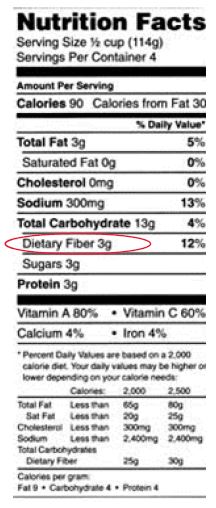
Dietary fiber on food labels
Dietary Supplement Labeling Guide: Chapter IV. Nutrition Labeling Total calories, calories from fat, total fat, saturated fat, cholesterol, sodium, total carbohydrate, dietary fiber, sugars, protein, vitamin A, vitamin C, calcium, and iron must be listed when... Dietary Fiber on the Food Label - Calorie Control Council Each ingredient in a food or beverage is listed on the package label alongside the Nutrition Facts Label. Fibers may be listed as a type of flour (e.g., wheat, rye, and oat) or as individual fibers. It is important to eat a wide range of dietary fibers from different sources to get all the benefits that fiber can provide. Fiber on Nutrition Facts Labels - Fiber Facts When comparing items with a nutrition facts label like bread, cereal, or breakfast bars, you should select the item with at least 2-3 grams of fiber per serving. You can also compare the amount of fiber to the percent daily value on the food label.
Dietary fiber on food labels. Reading Food Labels | ADA - American Diabetes Association The Nutrition Facts labels on foods are really the key to making the best choices. We'll cover the basics so that these labels make shopping easier for you. Get started Understanding Carbs You've heard it all. From carb-free to low-carb, to whole and empty carbs, it's hard to know what it all means. Learn more Food & Blood Sugar Understanding Fiber :: Diabetes Education Online On Nutrition Facts food labels, the grams of dietary fiber are already included in the total carbohydrate count. But because fiber is a type of carbohydrate that your body can't digest, it does not affect your blood sugar levels. You should subtract the grams of fiber from the total carbohydrate. ... The dietary fiber is 5 grams per serving. Understanding Food Labels | The Nutrition Source | Harvard T.H. Chan ... These statements describe the nutrients in a food beyond what is listed on the Nutrition Facts label, intended to showcase a health benefit of the food. An example is "Contains 100% Vitamin C.". Most terms like "low sodium," "high fiber," "reduced fat," and "good source of" are regulated by the FDA, and the nutrient amounts ... Questions and Answers on Dietary Fiber | FDA - U.S. Food and … 17.12.2021 · Manufacturer-Specific Questions What if a manufacturer wants to declare as "dietary fiber" on the Nutrition and Supplement Facts labels a non-digestible carbohydrate that is not intrinsic and ...
Declaring Dietary Fiber on Your Nutrition Facts Label with ... - ESHA There is still confusion among many food manufacturers as to what is required in order to accurately label dietary fiber on a product. According to the FDA, "dietary fiber that can be declared on the Nutrition and Supplement Facts labels includes certain naturally occurring fibers that are 'intrinsic and intact' in plants and added isolated or synthetic non-digestible soluble and ... How To Read Nutrition Labels - Mayo Clinic Diet The % Daily Value (DV) tells you how much a nutrient in a serving of food contributes to a daily diet. 2,000 calories a day is used for general nutrition advice. Low is 5% or less. Aim for low in saturated fat, trans fat, cholesterol, sodium, and added sugars. High is 20% or more. Aim high in vitamins, minerals and dietary fiber. 4. Fiber | Nutrition.gov This page provides lists of which foods have the most and least content of specific nutrients. Make Half Your Grains Whole Grains USDA, Food and Nutrition Service, Center for Nutrition Policy and Promotion Whole grains are important sources of many nutrients, including dietary fiber. Discover new ways to enjoy whole grains with these tips. Dietary Fiber on the Food Label - Fiber Facts Each ingredient in a food or beverage is listed on the package label alongside the Nutrition Facts Label. Fibers may be listed as a type of flour (e.g., wheat, rye, and oat) or as individual fibers. It is important to eat a wide range of dietary fibers from different sources to get all the benefits that fiber can provide.
Fiber & Food Labels | Home & Garden Information Center - Clemson University Nutrition Facts labels list goals for Americans as 25 grams of dietary fiber per day for a 2,000-calorie diet and 30 grams per day for a 2,500-calorie diet. Food is considered a high source of fiber if the % Daily Value listed on the Nutrition Facts label is 20% or more. It is a low source of fiber if the % Daily Value is 5% or less. PDF A Guide to Reading Food Labels - University of Rochester Dietary Fiber 0g ... Check the serving size on food labels to determine if the number of servings you are eating is smaller or larger. This will help you stay within your daily calorie goal. Calories . The number of calories is the total amount of energy the food provides. Pay attention to calories. High Fiber Diet: Types of Food & Health Benefits - Cleveland Clinic The Academy of Nutrition and Dietetics recommends consuming about 25-35 grams of total fiber per day, with 10-15 grams from soluble fiber or 14g of fiber per 1,000 calories. This can be accomplished by choosing 6 ounces of grains (3 or more ounces from whole grains), 2½ cups of vegetables, and 2 cups of fruit per day (based on a 2,000 calorie ... Whole Grains, Refined Grains, and Dietary Fiber | American Heart ... 01.11.2021 · This gives them a finer texture and improves their shelf life but strips the grain of important nutrients you need, including B-vitamins, iron and dietary fiber. Examples include white and wheat flours, enriched breads, and white rice. Now, refined grains are often enriched, which means some of the B vitamins and iron are added back in after processing. While that’s good, …
Food Labels | Nutrition.gov HHS, Food and Drug Administration, Center for Food Safety and Applied Nutrition Learn the difference between total sugars and added sugars, and discover how the Nutrition Facts Label can help you choose foods that are lower in added sugars. Folate and Folic Acid on the Nutrition and Supplement Facts Labels
Food energy - Wikipedia However, the direct calorimetric method generally overestimates the actual energy that the body can obtain from the food, because it also counts the energy contents of dietary fiber and other indigestible components, and does not allow for partial absorption and/or incomplete metabolism of certain substances. For this reason, today the energy content of food is instead obtained …
Dietary Fibers - A Source of Healthy Food & Beverage High-fiber helps to maintain a healthy weight as it is bulky and more filling than low fiber foods keeping a person to eat less and stay satisfied for a longer time. Benefits and use of dietary fiber in food products. Dietary fibers are includes in various kinds of food products like bakery, confectionery, cereals, and beverages. Benefits
Understanding Food Nutrition Labels | American Heart Association When choosing among different brands or similar products, compare labels and choose foods with less of these nutrients when possible.. 4 - Get enough of the beneficial nutrients. Make sure you get enough of the nutrients your body needs, such as: calcium, choline, dietary fiber, iron, magnesium, potassium, and vitamins A, C, D and E.*
Dietary Fiber on the Nutrition Facts Label | ESHA Research The final rule for FDA's 2016 updates to Nutrition Facts labeling incorporates two major changes to dietary fiber that food manufacturers need to be aware of: (1) a definition of "dietary fiber" - a term that FDA had not previously defined and (2) an increase in the DRV from 25 grams to 28 grams.
How are Carbohydrates & Dietary Fiber Labelled on Foods? The fibers listed below are the most common sources being added to food and can be declared on the Nutrition Facts label as dietary fiber. FDA approved isolated and synthetic non-digestible carbohydrates Gum Acacia Alginate Apple Fiber Bamboo Fiber Carboxymethylcellulose Corn Hull Fiber Cottonseed Fiber Galactooligosaccharides
How Much Fiber Per Day? Grams, Sources, Benefits, and More 11.04.2022 · The USDA’s Dietary Guidelines for Americans suggest the following amounts of fiber:. Women under 50: 25 to 28 grams per day Men under 50: 31 to 34 grams per day Women 51 and older: 22 grams per ...
Eye on Nutrition: Fiber | WIC Works Resource System The Dietary Fiber Fact Sheet offers tips to compare food labels to choose the item with more dietary fiber (of course, choosing the foods with less saturated fat, sodium, and added sugar is best!), such as: Look for whole grains on the Ingredients List (e.g., barley, brown rice, whole grain corn, quinoa, etc.). The closer an ingredient is to ...
Label Claims for Conventional Foods and Dietary Supplements 07.03.2022 · Among the claims that can be used on food and dietary supplement labels are three categories of claims that are defined by statute and/or FDA regulations: health claims, nutrient content claims ...
Food Labels | CDC - Centers for Disease Control and Prevention If you eat the whole thing, you are eating 8 times the amount of calories, carbs, fat, etc., shown on the label. Total Carbohydrate shows you types of carbs in the food, including sugar and fiber. Choose foods with more fiber, vitamins, and minerals. Choose foods with lower calories, saturated fat, sodium, and added sugars. Avoid trans fat.
Food Labeling & Nutrition | FDA Food labeling is required for most prepared foods, such as breads, cereals, canned and frozen foods, snacks, desserts, drinks, etc. Nutrition labeling for raw produce (fruits and vegetables) and...
Dietary Fiber on the Food Label - Fiber Facts Each ingredient in a food or beverage is listed on the package label alongside the Nutrition Facts Label. Fibers may be listed as a type of flour (e.g., wheat, rye, and oat) or as individual fibers. It is important to eat a wide range of dietary fibers from different sources to get all the benefits that fiber can provide.
Dietary fiber: Essential for a healthy diet - Mayo Clinic Jan 06, 2021 · Dietary fiber — found mainly in fruits, vegetables, whole grains and legumes — is probably best known for its ability to prevent or relieve constipation. But foods containing fiber can provide other health benefits as well, such as helping to maintain a healthy weight and lowering your risk of diabetes, heart disease and some types of cancer.
PDF Eat Smart with Food Nutrition Labels - American Heart Association Compare labels when possible and choose options with lower amounts of added sugars, sodium and saturated fat and no trans fat. Get enough of beneficial nutrients. Eat foods with nutrients your body needs, like calcium, dietary fiber, iron, potassium and Vitamin D. Understand % Daily Value. • The % Daily Value (DV) tells you the
How to Understand and Use the Nutrition Facts Label | FDA Dietary fiber, vitamin D, calcium, iron ad potassium are nutrients on the label that Americans generally do not get the recommended amount of. They are identified as nutrients to get more of....
Understanding Ingredients on Food Labels - American Heart … 06.03.2017 · Food labels are an important source of information about calories and the nutritional value of the foods you eat, a crucial tool in building a heart-healthy diet. The Nutrition Facts information is always displayed in the same orderly fashion and helps you understand how much of certain nutrients that you need to limit are contained in the product per serving.
How To Read Food and Beverage Labels - National Institute on Aging At the top of the Nutrition Facts label, you will find the total number of servings in the container and the food or beverage's serving size. The serving size on the label is based on the amount of food that people may typically eat at one time and is not a recommendation of how much to eat. Read more about serving and portion sizes.
Fiber on Nutrition Facts Labels - Fiber Facts When comparing items with a nutrition facts label like bread, cereal, or breakfast bars, you should select the item with at least 2-3 grams of fiber per serving. You can also compare the amount of fiber to the percent daily value on the food label.
Dietary Fiber on the Food Label - Calorie Control Council Each ingredient in a food or beverage is listed on the package label alongside the Nutrition Facts Label. Fibers may be listed as a type of flour (e.g., wheat, rye, and oat) or as individual fibers. It is important to eat a wide range of dietary fibers from different sources to get all the benefits that fiber can provide.
Dietary Supplement Labeling Guide: Chapter IV. Nutrition Labeling Total calories, calories from fat, total fat, saturated fat, cholesterol, sodium, total carbohydrate, dietary fiber, sugars, protein, vitamin A, vitamin C, calcium, and iron must be listed when...
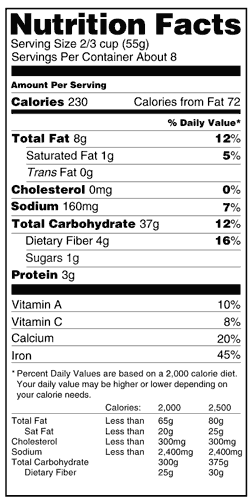
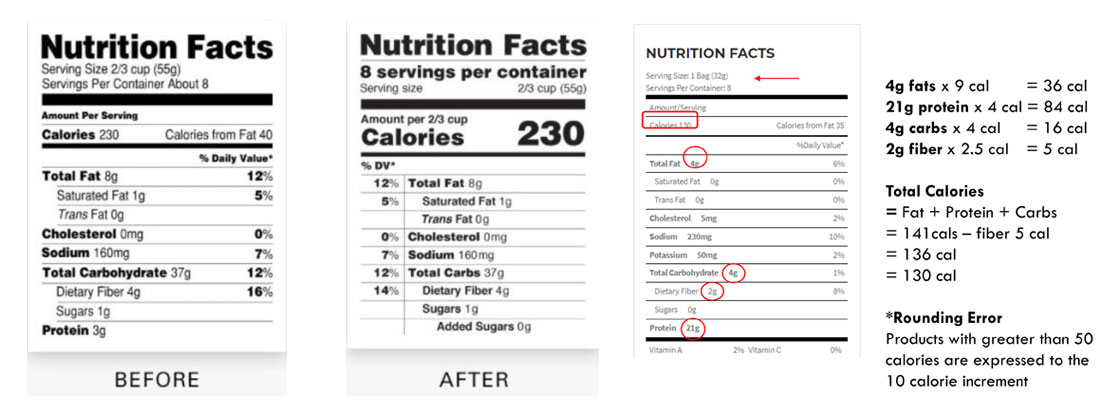

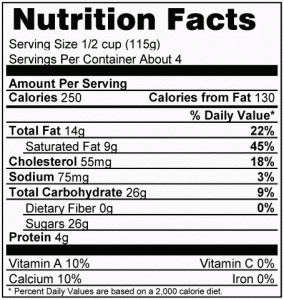

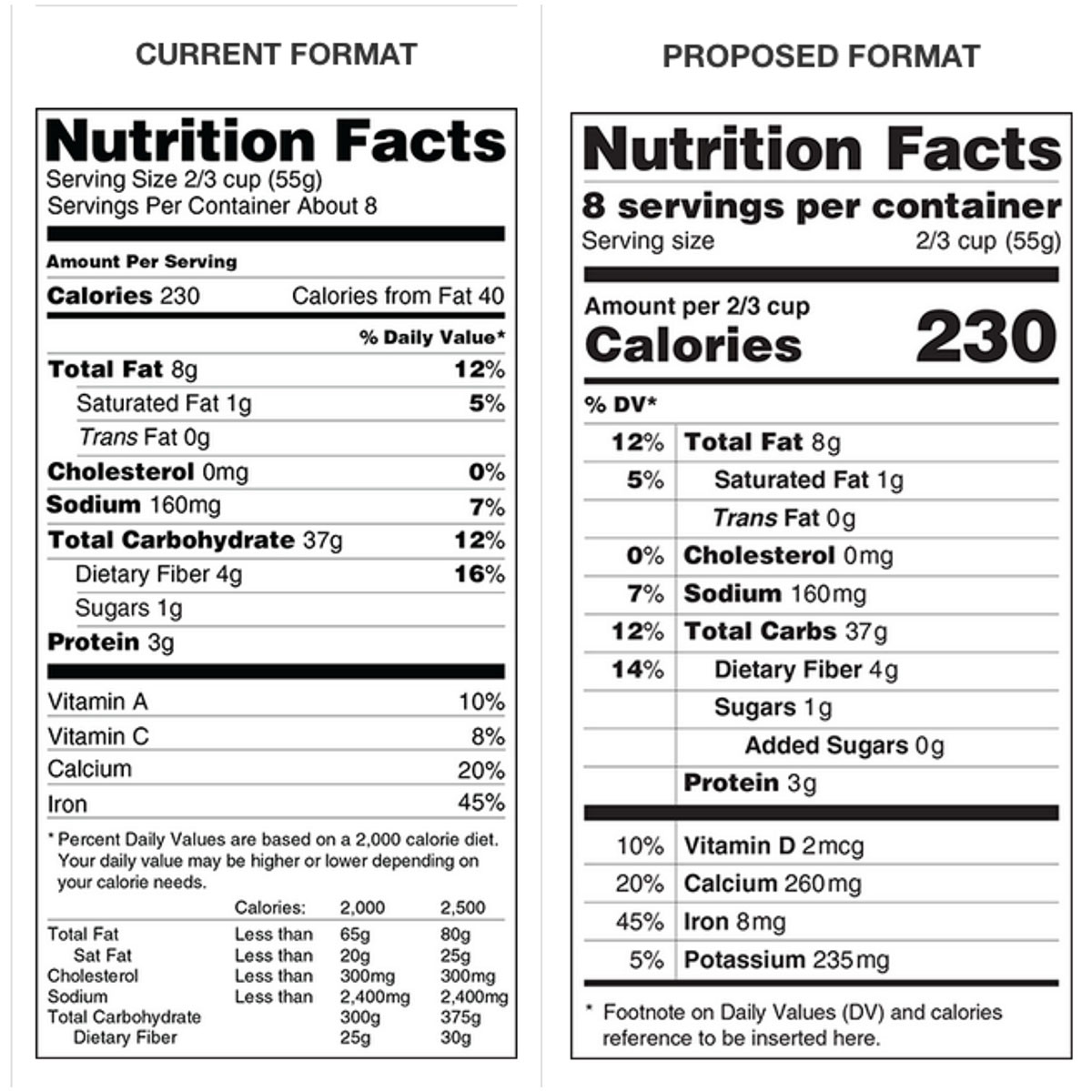

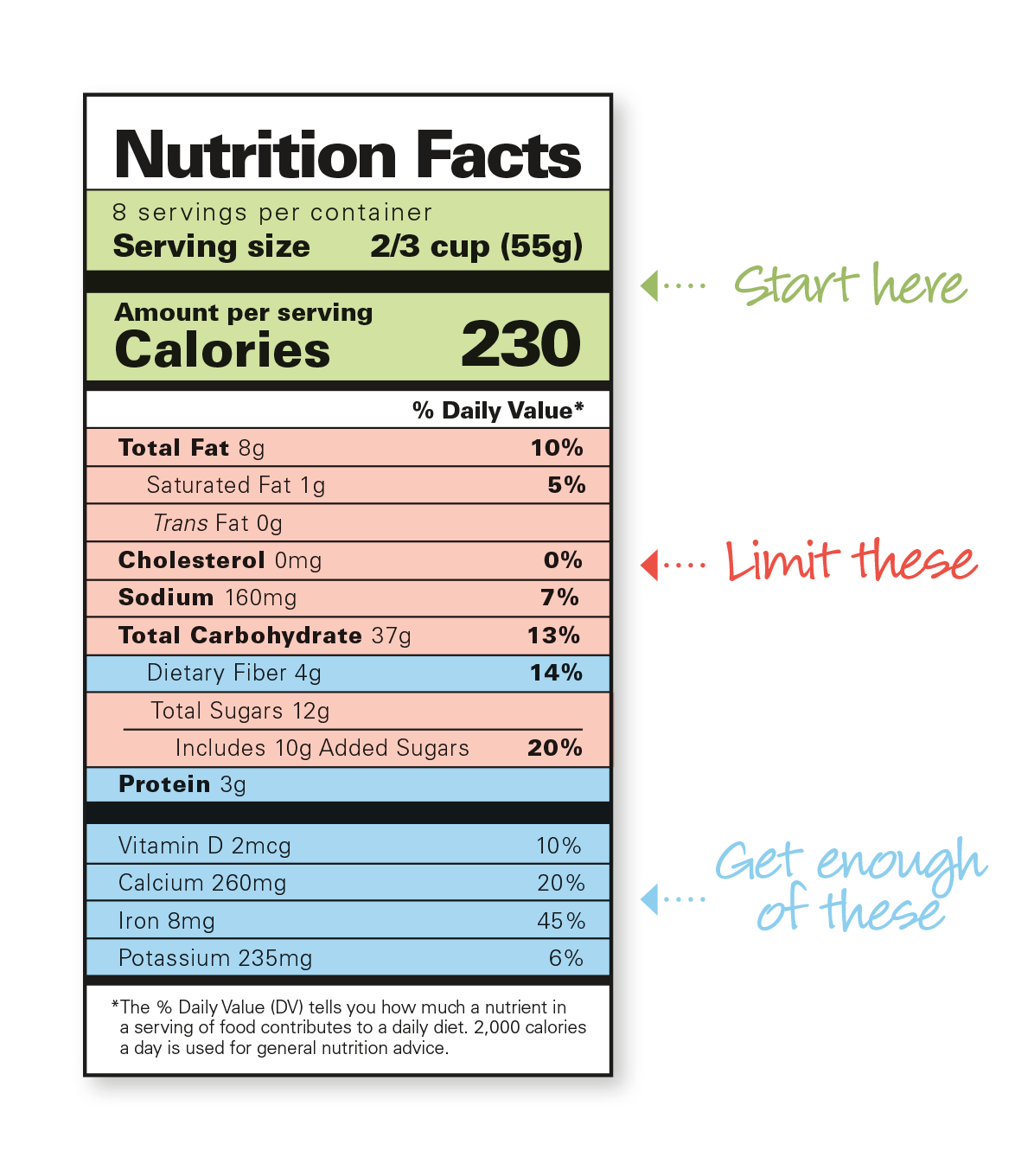

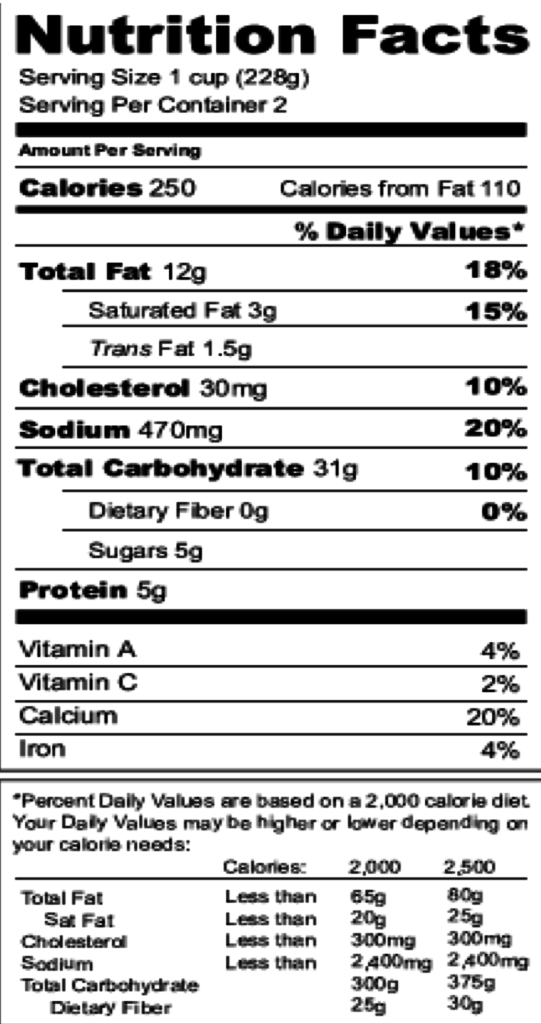
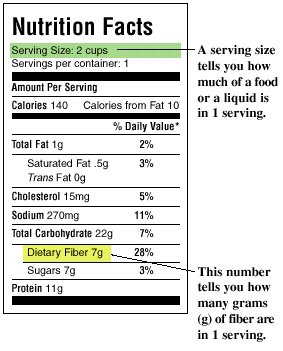










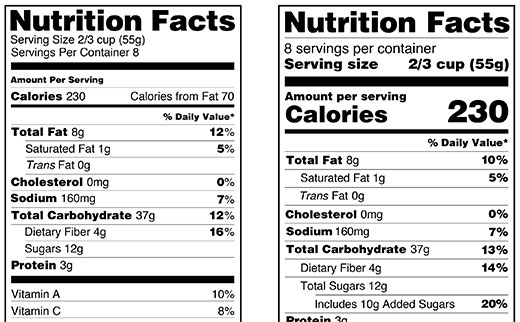

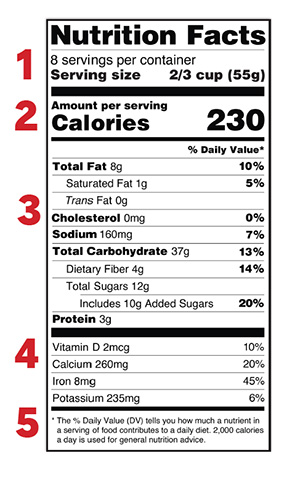
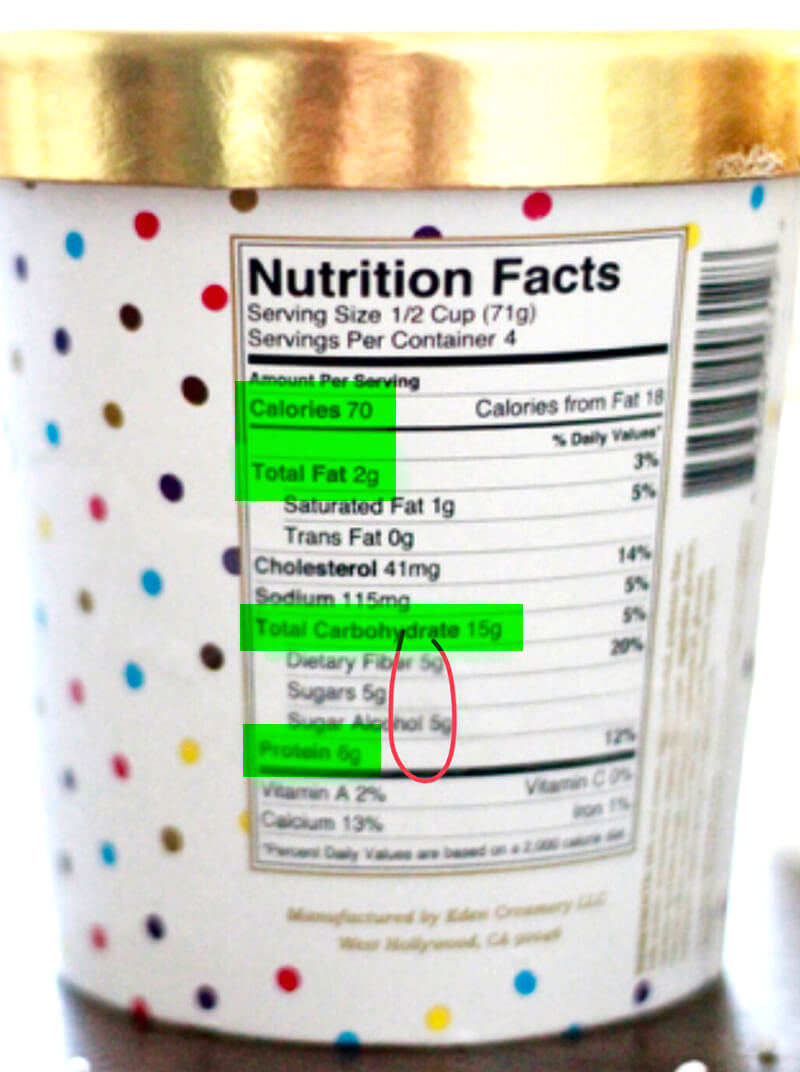
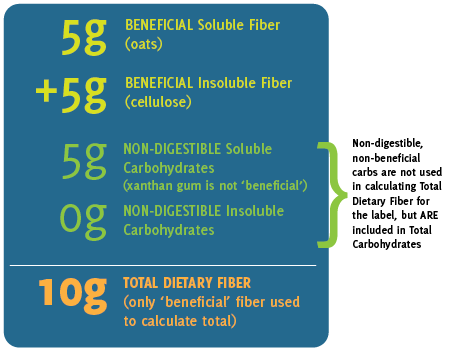

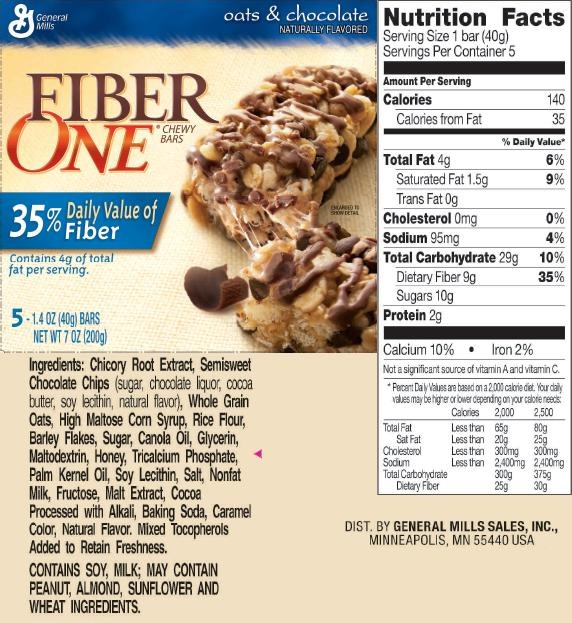
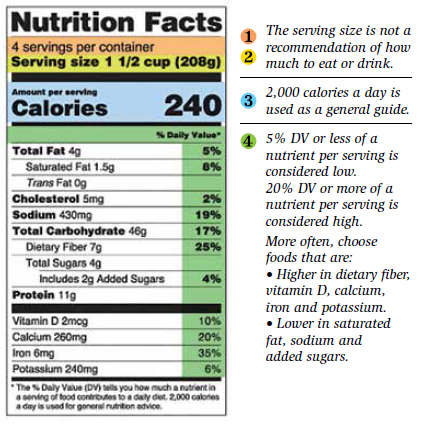
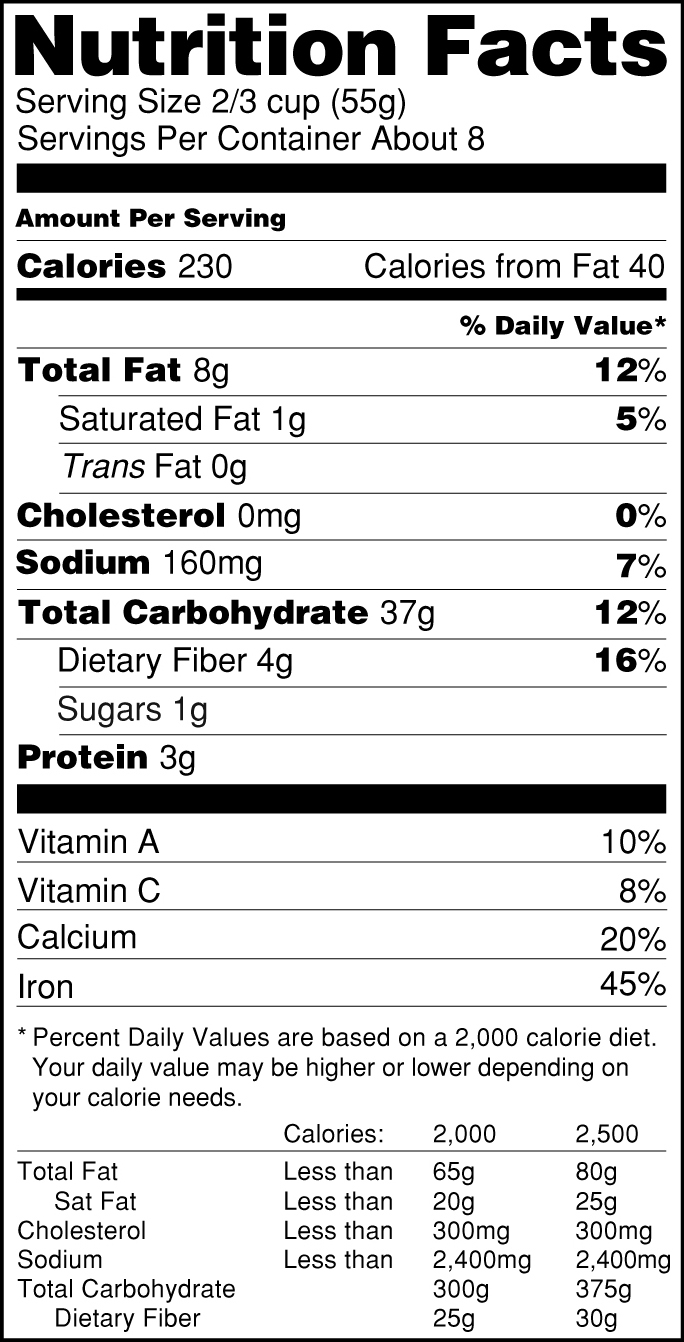
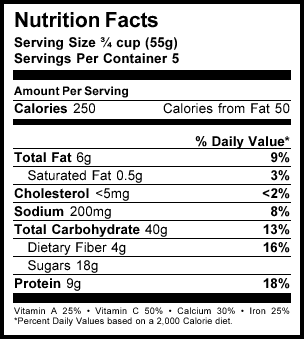

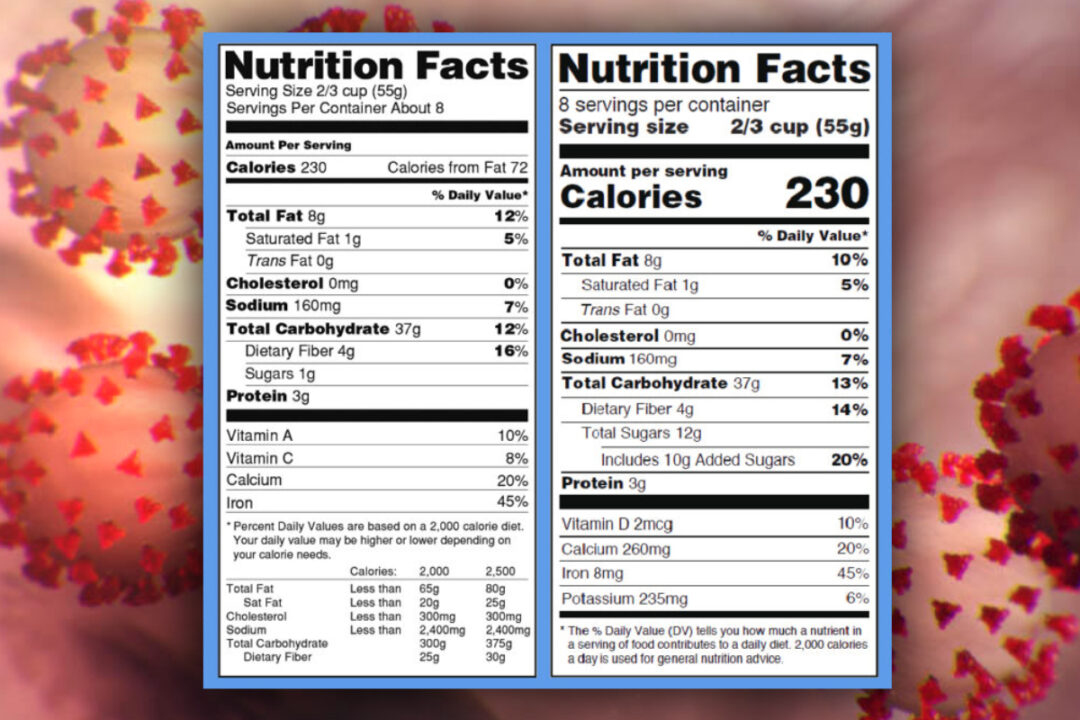
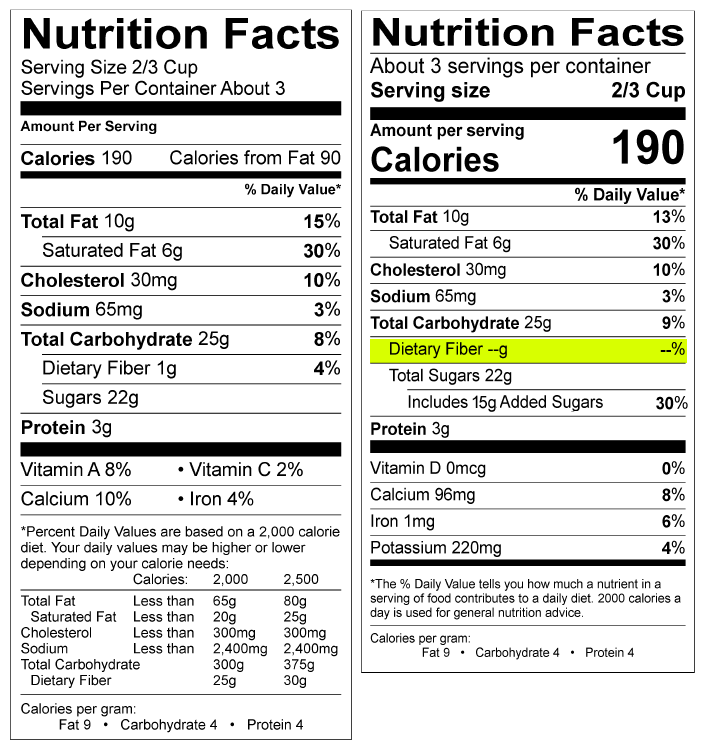
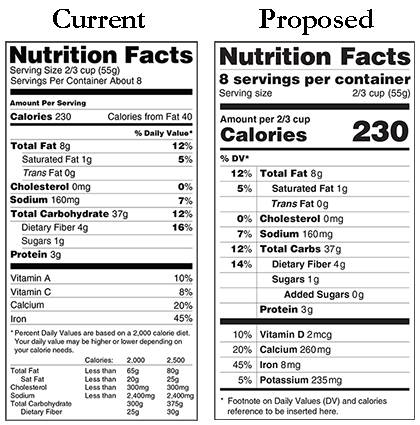
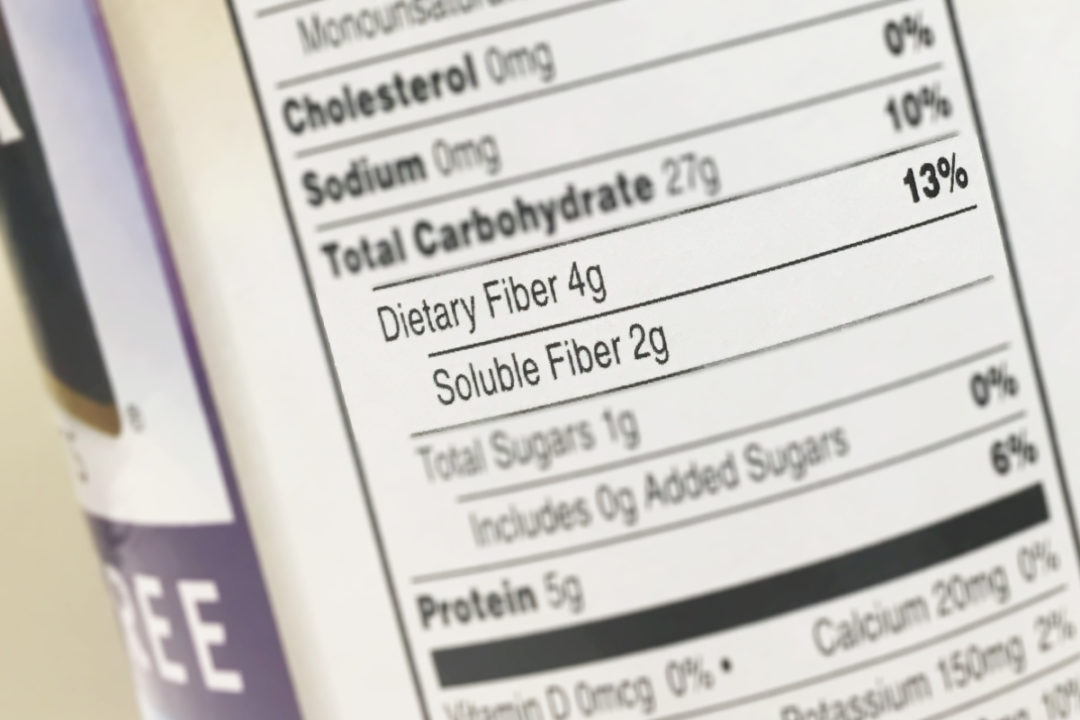
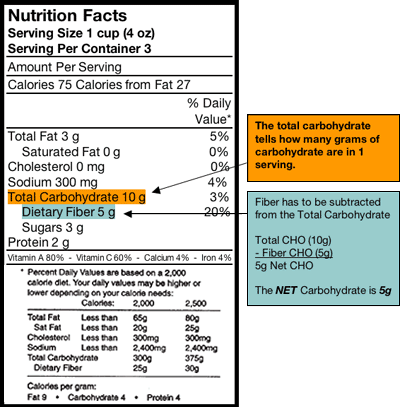
Post a Comment for "42 dietary fiber on food labels"